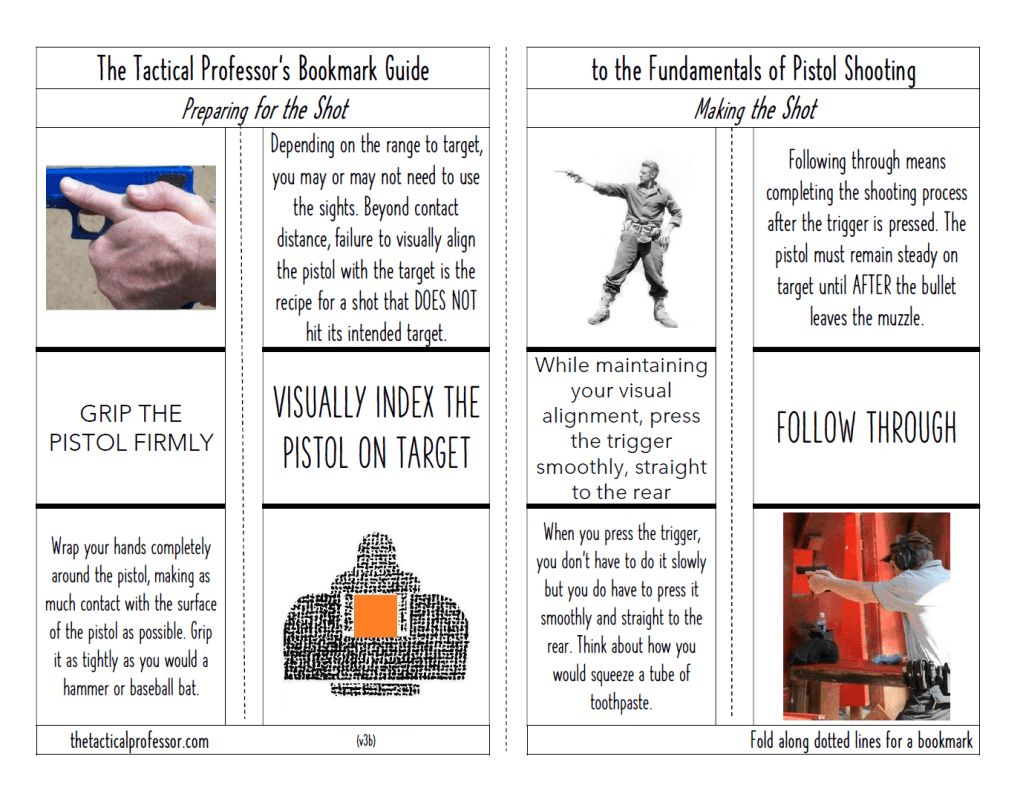#fridayfundamentals

My friend and colleague Brian Hill of The Complete Combatant http://www.thecompletecombatant.com/ has a unique perspective on one of the decision-making aspects of the Fundamentals. It was touched on in Part 1 of this series https://tacticalprofessor.wordpress.com/2021/11/05/fundamentals-of-pistol-shooting-part-1/. He has generously contributed the following post to expand and explain his viewpoint.
The Three Choices
The act of drawing from concealment to the first shot is the essential skill for the armed citizen, whether we are practicing, competing, or protecting ourselves. To improve the probability of success, the action requires a “recognition primed decision,” to use Gary Klein’s phrase. There are only three possible courses of action for the shooter once the decision to shoot has been reached. The need for a mental model which is conducive to quick decisions can be explained as follows.
1-Shoot
If the shooter can perform a clean draw, align the sights or index the pistol relative to the target, then the decision should be primed that the pattern is correct and to execute the process of shooting. This decision will be compressed to a short period of time; therefore, the intuition will recognize the correctness with feedback from both vision and feel. This observation will be based on the feeling of fluidity and efficiency of the movement with a visual confirmation of alignment allowing the pattern to be recognized as “good enough” relative to the size of the target. The shooter is not using a comparative analysis but a recognition of previous successes.
2-Correct and then shoot
Often pressure or lack of skill will alter this process; therefore, the shooter will have to correct either the physical index or visual alignment of the sight and target, or both. The pattern will be recognized as not “good enough,” and a correction will be applied. This correction cost the shooter a quarter of a second to make a correction which is much faster than firing another shot which may be no better than the previous one. Of course, the other possibility is looking to the target for indication of success or failure, and the minimum amount of time for this type of correction is .75 to 1.5 seconds. The more we practice the correct pattern, the faster the recognition primed decision happens. Experts gain an advantage in processing speed and a significant probability of making the right decision sooner, hence the need for practice.
3-Assess new information
Finally, as the shooter commits to the shooting process, something changes, the target disappears, changes, or stops needing to be engaged; therefore, the shooter needs to assess a possible new course of action, such as stopping the process of shooting, going to a ready position and taking the finger off the trigger, or moving away. Using the previous two steps, if there is not a “good enough” solution and no correction can be made, requires the shooter to reevaluate the situation. If there is any doubt then the answer is no, and the shooter needs to adjust or stop.
Shooting happens in highly compressed time periods, but the properly prepared mind will be able to perform efficiently and consistently. The key is repeated exposure to both success and failure, allowing the priming of the process. Practice with this style of immediate feedback will allow progress rapidly and is the key to competency under pressure.
The Complete Combatant http://www.thecompletecombatant.com/
Everything we hear is an opinion, not a fact. Everything we see is a perspective, not the truth.
–Marcus Aurelius
In addition to the alignment process of the pistol to the target Brian mentions, the smoothness of the trigger press necessary will influence the success of the shot. Shooters are often victims of “urgency bias” with regard to trigger press. This is akin to the common human tendency to feel “I have to do something NOW.” Urgency bias can lead to “El Snatcho” and can negate the alignment of the pistol with the target. So, the necessary smoothness is also a decision that the shooter must make. What will suffice at two yards will probably not lead to good results at 10 yards. It is also a recognition primed decision that is only learned through practice.
The final part of the series will focus on the most important, consequential, and least practiced aspect of the Fundamentals, DON’T SHOOT/SHOOT.
Part I https://tacticalprofessor.wordpress.com/2021/11/05/fundamentals-of-pistol-shooting-part-1/
Part 2 https://tacticalprofessor.wordpress.com/2021/11/12/fundamentals-of-pistol-shooting-part-2/
Part 3 https://tacticalprofessor.wordpress.com/2021/11/22/fundamentals-of-pistol-shooting-part-3/
Part 4 https://tacticalprofessor.wordpress.com/2021/12/03/fundamentals-of-pistol-shooting-part-4/
Part 5 https://tacticalprofessor.wordpress.com/2021/12/10/fundamentals-of-pistol-shooting-part-5/
Part 6 https://tacticalprofessor.wordpress.com/2021/12/17/fundamentals-of-pistol-shooting-part-6/
Tactical Professor books (all PDF)
- Indoor Range Practice Sessions http://indoorrangepracticesessions.com
- Concealed Carry Skills and Drills http://concealedcarryskillsanddrills.com
- Advanced Pistol Practice http://bit.ly/advancedpistolpractice
- Real Shootouts of the LAPD https://realshootoutsofthelapd.com/
- Thinking Clearly about Self-defense and Personal Protection https://www.payloadz.com/go?id=3377208
- Serious Mistakes Gunowners Make http://seriousgunownermistakes.com
- Shooting Your Black Rifle http://shootingyourblackrifle.com
- Package deal of Thinking Clearly about Self-defense and Personal Protection, Serious Mistakes, Indoor Sessions, Concealed Carry, and Shooting Your Black Rifle (50% off) https://store.payloadz.com/details/2644448-ebooks-sports-shooting-drills-package.html
Purchase of any book includes Serious Mistakes Gunowners Make.